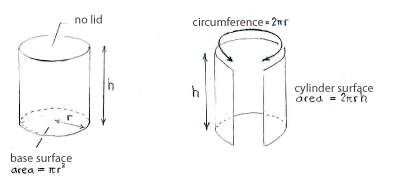Lösung 1.3:6
Aus Online Mathematik Brückenkurs 2
K (Solution 1.3:6 moved to Lösung 1.3:6: Robot: moved page) |
|||
| Zeile 1: | Zeile 1: | ||
| - | + | Wir benennen den Radius der Tasse ''r'' und die Höhe ''h''. Der Volumen ist | |
{{Abgesetzte Formel||<math>\begin{align} | {{Abgesetzte Formel||<math>\begin{align} | ||
| - | \text{Volume} &= \text{( | + | \text{Volume} &= \text{(Fläche der Basis)}\cdot\text{(Höhe)}\\[5pt] |
&= \pi r^2\cdot h\,,\\[10pt] | &= \pi r^2\cdot h\,,\\[10pt] | ||
| - | \text{ | + | \text{Fläche} &= \text{(Fläche der Basis)} + \text{(Fläche des Zylinders)}\\[5pt] |
&= \pi r^2 + 2\pi rh\,\textrm{.} | &= \pi r^2 + 2\pi rh\,\textrm{.} | ||
\end{align}</math>}} | \end{align}</math>}} | ||
| Zeile 10: | Zeile 10: | ||
[[Image:1_3_6_1.gif|center]] | [[Image:1_3_6_1.gif|center]] | ||
| - | + | Das Problem ist also; Minimiere die Fläche <math>A = \pi r^2 + 2\pi h</math>, während der Volumen <math>V = \pi r^2h\,</math>, konstant ist. | |
| - | + | Wir schreiben ''h'' als Funktion des Volumen, | |
{{Abgesetzte Formel||<math>h=\frac{V}{\pi r^2}</math>}} | {{Abgesetzte Formel||<math>h=\frac{V}{\pi r^2}</math>}} | ||
| - | + | und können dadurch die Fläche als Funktion von ''r'' schreiben, | |
{{Abgesetzte Formel||<math>A = \pi r^2 + 2\pi r\cdot\frac{V}{\pi r^2} = \pi r^2 + \frac{2V}{r}\,\textrm{.}</math>}} | {{Abgesetzte Formel||<math>A = \pi r^2 + 2\pi r\cdot\frac{V}{\pi r^2} = \pi r^2 + \frac{2V}{r}\,\textrm{.}</math>}} | ||
| - | + | Unser Problem ist dann | |
| - | :: | + | ::Minimiere die Flächea <math>A(r) = \pi r^2 + \frac{2V}{r}</math>, wenn <math>r>0\,</math>. |
| - | + | Die Funktion <math>A(r)</math> ist für alle <math>r>0</math> differenzierbar, und der Bereich <math>r>0</math> hat keine Endpunkte (nachdem <math>r=0</math> nicht <math>r>0</math> erfüllt), und also erscheinen Extrempunkte nur in stationären Punkten. | |
| - | + | Die Ableitung ist | |
{{Abgesetzte Formel||<math>A'(r) = 2\pi r - \frac{2V}{r^2}\,,</math>}} | {{Abgesetzte Formel||<math>A'(r) = 2\pi r - \frac{2V}{r^2}\,,</math>}} | ||
| - | + | Und die Ableitung gleich null ergibt folgende Gleichung | |
{{Abgesetzte Formel||<math>\begin{align} | {{Abgesetzte Formel||<math>\begin{align} | ||
| Zeile 37: | Zeile 37: | ||
\end{align}</math>}} | \end{align}</math>}} | ||
| - | + | Die zweite Ableitung ist | |
{{Abgesetzte Formel||<math>A''(r) = 2\pi + \frac{4V}{r^3}\,,</math>}} | {{Abgesetzte Formel||<math>A''(r) = 2\pi + \frac{4V}{r^3}\,,</math>}} | ||
| - | + | und hat den Wert | |
{{Abgesetzte Formel||<math>A''\bigl(\sqrt[3]{V/\pi}\bigr) = 2\pi + \frac{4V}{V/\pi } = 6\pi > 0\,,</math>}} | {{Abgesetzte Formel||<math>A''\bigl(\sqrt[3]{V/\pi}\bigr) = 2\pi + \frac{4V}{V/\pi } = 6\pi > 0\,,</math>}} | ||
| - | + | im stationären Punkt. | |
| - | + | Also ist <math>r=\sqrt[3]{V/\pi}</math> ein lokales Minima. | |
| - | + | ||
| - | + | ||
| - | + | ||
| - | + | Nachdem wir kein begrenztes Intervall haben, können wir nicht direkt ausschließen dass die Fläche kleiner wird wenn <math>r\to 0</math> oder wenn <math>r\to \infty </math>. In unseren Fall wächst die Fläche aber unbegrenzt in den beiden Richtungen <math>r\to 0</math> und <math>r\to \infty </math>, und also ist | |
| + | <math>r=\sqrt[3]{V/\pi}</math> ein globales Minima. | ||
| + | |||
| + | Also ist die Fläche minimal wenn | ||
{{Abgesetzte Formel||<math>\begin{align} | {{Abgesetzte Formel||<math>\begin{align} | ||
Version vom 12:19, 27. Apr. 2009
Wir benennen den Radius der Tasse r und die Höhe h. Der Volumen ist
| \displaystyle \begin{align}
\text{Volume} &= \text{(Fläche der Basis)}\cdot\text{(Höhe)}\\[5pt] &= \pi r^2\cdot h\,,\\[10pt] \text{Fläche} &= \text{(Fläche der Basis)} + \text{(Fläche des Zylinders)}\\[5pt] &= \pi r^2 + 2\pi rh\,\textrm{.} \end{align} |
Das Problem ist also; Minimiere die Fläche \displaystyle A = \pi r^2 + 2\pi h, während der Volumen \displaystyle V = \pi r^2h\,, konstant ist.
Wir schreiben h als Funktion des Volumen,
| \displaystyle h=\frac{V}{\pi r^2} |
und können dadurch die Fläche als Funktion von r schreiben,
| \displaystyle A = \pi r^2 + 2\pi r\cdot\frac{V}{\pi r^2} = \pi r^2 + \frac{2V}{r}\,\textrm{.} |
Unser Problem ist dann
- Minimiere die Flächea \displaystyle A(r) = \pi r^2 + \frac{2V}{r}, wenn \displaystyle r>0\,.
Die Funktion \displaystyle A(r) ist für alle \displaystyle r>0 differenzierbar, und der Bereich \displaystyle r>0 hat keine Endpunkte (nachdem \displaystyle r=0 nicht \displaystyle r>0 erfüllt), und also erscheinen Extrempunkte nur in stationären Punkten.
Die Ableitung ist
| \displaystyle A'(r) = 2\pi r - \frac{2V}{r^2}\,, |
Und die Ableitung gleich null ergibt folgende Gleichung
| \displaystyle \begin{align}
& 2\pi r - \frac{2V}{r^2} = 0\quad \Leftrightarrow \quad 2\pi r = \frac{2V}{r^2}\\[5pt] &\quad\Leftrightarrow \quad r^3=\frac{V}{\pi}\quad \Leftrightarrow \quad r=\sqrt[\scriptstyle 3]{\frac{V}{\pi}}\,\textrm{.} \end{align} |
Die zweite Ableitung ist
| \displaystyle A''(r) = 2\pi + \frac{4V}{r^3}\,, |
und hat den Wert
| \displaystyle A''\bigl(\sqrt[3]{V/\pi}\bigr) = 2\pi + \frac{4V}{V/\pi } = 6\pi > 0\,, |
im stationären Punkt.
Also ist \displaystyle r=\sqrt[3]{V/\pi} ein lokales Minima.
Nachdem wir kein begrenztes Intervall haben, können wir nicht direkt ausschließen dass die Fläche kleiner wird wenn \displaystyle r\to 0 oder wenn \displaystyle r\to \infty . In unseren Fall wächst die Fläche aber unbegrenzt in den beiden Richtungen \displaystyle r\to 0 und \displaystyle r\to \infty , und also ist
\displaystyle r=\sqrt[3]{V/\pi} ein globales Minima.
Also ist die Fläche minimal wenn
| \displaystyle \begin{align}
r &= \sqrt[3]{V/\pi}\,,\quad\text{and}\\[5pt] h &= \frac{V}{\pi r^{2}} = \frac{V}{\pi}\Bigl(\frac{V}{\pi}\Bigr)^{-2/3} = \Bigl( \frac{V}{\pi}\Bigr)^{1-2/3} = \Bigl(\frac{V}{\pi}\Bigr)^{1/3} = \sqrt[3]{\frac{V}{\pi}}\,\textrm{.} \end{align} |

